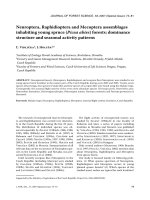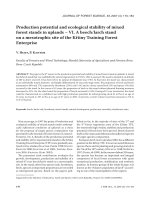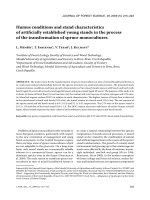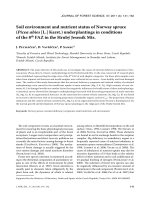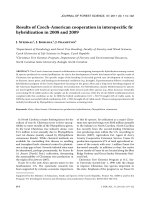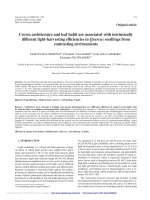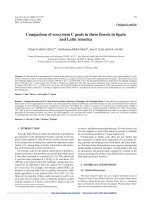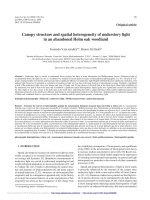Báo cáo lâm nghiệp: "Geographic variation and bud dormancy in seedlings (Fagus sylvatica L)" potx
Bạn đang xem bản rút gọn của tài liệu. Xem và tải ngay bản đầy đủ của tài liệu tại đây (704.13 KB, 13 trang )
Original
article
Geographic
variation
and
bud
dormancy
in
beech
seedlings
(Fagus
sylvatica
L)
M
Falusi,
R
Calamassi
Dipartimento
di
Biologia
Vegetale,
Laboratori
di
Botanica
agraria
e
forestale,
Università
di
Firenze,
Piazzale
delle
Cascine
28, 50134
Florence,
Italy
(Received
10
March
1995;
accepted
23
August
1995)
Summary -
Italian
populations
of
beech,
originating
from
zones
of
similar
altitudes
but
different
latitudes
(38°16’-43°49’N),
were
studied.
The
seedlings,
1
and
2
years
old,
were
grown
in
Florence
(43°45’)
under
natural
conditions
or
in
climate-controlled
chambers
with
short
(SD)
or
long
day
(LD)
after
having
been
exposed,
or
not,
to
winter
chilling
(CH and NCH,
respectively).
Differences
observed
in
precociousness
of
sprouting,
thermal
time,
growth
in
length
and
duration
of
growing
season
all
indicate
a
variation
among
the
populations
tied
to
the
latitude
of
their
zones
of
origin.
Winter
chilling
was
demonstrated
to
be
the
principal
factor
in
the
removal
of
dormancy
in
all
the
populations
studied.
In
the
northernmost
populations
a
significant
effect
on
sprouting
was
attributable
also
to
photoperiodic
regime.
The
interaction
chilling
x
long
day
indicates
that
LD
is
able
to
partially
substitute
winter
chilling
and
that
once
the
need
for
removal
of
dormancy
has
been
satisfied,
temperature
is
presumably
the
principal
environmental
factor
that
controls
sprouting.
bud
dormancy
/
chilling
/
Fagus
sylvatica
/ growing
season
/
photoperiod
Résumé -
Variation
géographique
et
dormance
des
bourgeons
chez
de
jeunes
plants
de
hêtre
(Fagus
sylvatica
L).
Sur
de
jeunes
plantules
de
hêtre,
on
a
étudié
la
variation
géographique
du
débourrement
printanier
et
l’influence
qu’ont
le
froid
pendant
l’hiver
et
le
régime
photopériodique
sur
la
sortie
de
dormance.
Les
altitudes
des
lieux
de
provenance
du
matériel
sont
identiques,
mais
les
latitudes
sont
différentes.
Dans
la
première
expérience
on
a
cultivé
les
plantules
des
trois
populations
(Bagno
di
Romagna,
latitude
43° 49’N;
Pacentro,
latitude
42° 03’N;
Aspromonte,
latitude
39° 09’N)
à
Florence
(latitude
43° 45’N)
aux
conditions
climatiques
naturelles.
Avec
l’augmentation
de
la
latitude
des
stations
de
provenance
le
débourrement
printanier
devient
plus
précoce
(fig 1)
et
la
croissance
en
longueur,
le
«
thermal
time
»
et
le
temps
entre
le
débourrement
du
bourgeon
apical
et
celui
des
bourgeons
latéraux
raccourcissent
(tableau
I).
D’après
la
deuxième
expérience
effectuée
sur
les
plantules
de
deux
provenances
(Casentino,
latitude
43° 48’ N,
et
Aspromonte,
latitude
38°
16’ N)
exposées
ou non
au
froid
hivernal
puis
cultivées
en
conditions
naturelles
à
Florence,
les
résultats
de
la
première
expérience
ont
été
confirmés
en
ce
qui
concerne
le
débourrement
et
la
croissance
(tableau
II,
figs
2
et
3).
En
outre
un
polycyclisme
très
net
chez
la
population
méridionale
et
une
forte
dépendance
du
débourrement
vis-à-vis
de
la
période
de
froid préalable
ont
été
démontrés
(tableau
II,
figs
2
et
3).
Chez
les
deux
provenances
les
plantules
exposées
aux
froid
en
hiver
présentent
un
débourrement
plus
précoce
et
plus
rapide
par
comparaison
avec
celles
qui
n’ont
pas
été
exposées.
Cet
effet
est
particulièrement
évident
dans
le
cas
des
bourgeons
latéraux
(figs
2
et
3).
Lorsqu’on
élève
en
chambre
climatisée,
à
jours
longs
ou
courts,
les
plantules
des
populations
de
la
deuxième
expérience
en
les
ayant
exposées
ou
non
au
froid
hivernal,
les
différences
entre
populations
sont
confirmées
en
ce
qui
concerne
la
précocité
du
débourrement,
la
croissance
en
longueur
et
la
durée
de
la
période
de
végétation
(tableau
III
et
fig
4).
L’effet
très
net
du
froid
hivernal
sur
la
sortie
de
dormance
(tableau
III)
et
sur
le
débourrement
qui
s’ensuit
des
bourgeons
apicaux
et
axillaires
(tableau
V)
est
aussi
confirmé.
En
effet
la
période
nécessaire
pour
obtenir
la
totalité
du
débourrement
est
plus
longue
de
100-150
jours
(fig
4)
chez
les
plantules
non
exposées
au
froid.
On
a
aussi
observé
un
effet
du
photopériodisme,
qui
semble
être
une
caractéristique
de
la
population
la
plus
septentrionale
(tableaux
V,
VI
et
VII).
Les
effets
des
jours
longs
sont
nets
sur
les
temps
moyens
et
sur
le
pourcentage
de
débourrement
et
sur
la
somme
des
degrés-jours.
L’interaction
entre jour
long
et
froid
en
hiver
laisse
penser
que
le jour
long
est
très
impliqué
dans
la
sortie
de
dormance
et peut
se
substituer
partiellement
aux
besoins
en
froid.
Une
fois satisfaites
les
exigences
pour la
sortie
de
dormance,
c’est la
température
qui intervient
comme
principal
facteur
du
milieu
controlant
le
débourrement.
Les
différences
observées
au
cours
de
toutes
les
expériences
en
ce
qui
concerne
la
précocité
de
débourrement,
la
croissance
en
longueur
et
la
durée
de
la
saison
de
végétation
indiquent
toutes
l’existence
parmi
les
populations
de
variations
liées
à
la
latitude
des
lieux
d’origine.
dormance
des
bourgeons
/
exposition
au
froid
/
Fagus
sylvatica
/
saison
de
végétation
/
photopériode
INTRODUCTION
The
seedlings
of
many
tree
species
follow
a
rhythmic
alternation
of
growth
and
non-
growth
when
they
are
maintained
under
constant
conditions
in
long
days
or
a
24
h
day
(Lavarenne
et
al,
1971;
Barnola
et
al,
1986).
The
nature
of
the
nongrowth
phase
is
not
the
same
in
all
species,
however
(Barnola
et
al,
1977,
1986).
Wareing
(1953)
reported
that
for
Fagus
sylvatica
L
seedlings
the
nongrowth
phase
was
a
state
of
dormancy,
and
that
it
was
induced
by
short
days
(SD),
and
broken
by
long
days
(LD).
The
photoperiodic
nature
of
stimulus
perceived
by
the
bud
was
shown
by
Wareing
(1953,
1954).
More
re-
cently,
however,
Bagni
etal
(1980)
reported
that
under
natural
conditions
sprouting
in
F sylvatica
seedlings
in
spring
also
depended
upon
prior
chilling
received.
Fa-
lusi
and
Calamassi
(1990),
also
working
with
seedlings,
found
that
chilling
was
in
fact
the
predominant
factor
determining
rapid
release
from
bud
dormancy
and
bringing
about
the
internal
changes
in
the
seedlings
that
lead
to
an
acrotonal
vegeta-
tive
habit.
Heide
(1993)
reported
that
in
beech
provenances
from
northern
and
central
Europe,
both
chilling
and
sub-
sequent
long
days
were
required
for
normal
bud
sprouting,
but
he
found
no
variation
in
critical
photoperiod
among
the
ecotypes
he
studied.
The
diversity
of
these
findings
suggests
that
differences
in
the
qualitative
and
quan-
titative
requirement
for
dormancy
release
may
be
due
to
geographical
differences.
Wareing
(1953)
suggested
that
the
control-
ling
factor
for
budding
in
beech
was
the
photoperiod
for
southern
populations
and
thermic
conditions
for
the
northernmost
populations.
Later
studies
(Galoux,
1966;
Teissier-du-Cros
et
al,
1988)
on
beech
have
shown
that
spring
budding,
which
is
characterized
by
strong
genetic
control
and
genotype
x
environment
interaction,
is
dif-
ferent
under
natural
conditions
in
popula-
tions
at
low
and
high
elevation.
Geographical
variation
in
the
factors
that
bring
about
release from
dormancy
is found
in
many
other
tree
species
(Heide,
1974;
Campbell
and
Sugano,
1975;
Downs
and
Bevington,
1981; Worrall,
1983; Oleksyn et
al, 1992).
In
a
previous
study
on
beech
(Falusi
and
Calamassi,
1990),
a
weak
interaction
was
observed
between
chilling
and
daylength
to
achieve
dormancy
release.
The
present
study
was
undertaken
to
investigate
whether
the
role
of
daylength
varied
with
latitudinal
origin
of
the
provenances.
MATERIALS
AND
METHODS
Plant
material
Seeds
were
collected
from
20
trees
growing
at
least
50
m
apart
in
each
of
five
areas
(located
at
similar
altitudes):
i)
Appennino
Tosco-Emiliano
(Bagno
di
Romagna,
latitude
43°49’N,
altitude
1
300
m),
ii)
Abruzzo
(Pacentro,
latitude
42°03’
N,
altitude
1
070
m),
iii)
Aspromonte
(Monte
Ba-
silicò,
latitude
39°09’N,
altitude
1
400
m),
iv)
Casentino
(Pratovecchio,
latitude
43°48’N,
alti-
tude
1
170
m),
v)
Aspromonte
(Oppido
Mamer-
tino,
latitude
38°16’N,
altitude
1
050
m).
The
seeds
were
stratified
for
6
weeks
at
3
±
0.5
°C
and
germinated
during
spring
in
dark-
ness
at
20
±
0.5°
in
transparent
polystyrene
ger-
minators
(diameter
12
cm)
on
filter
paper
satu-
rated
with
deionized
water.
The
resulting
seedlings
were
transferred
to
pots
containing
beech-wood
loam
and
were
grown
under
natural
conditions
in
Florence
(43°45’N),
and
used
as
needed
for
the
experiments.
The
seedlings,
which
spent
a
year
in
the
nursery
before
being
used
(experiment
3)
were
watered
and
fertilized
regularly
(as
indicated
later)
and
protected
dur-
ing
summer
by
a
Umbratex
netting
which
re-
duces
light
intensity
by
40-50%.
Methods
Experiment
1
This
experiment
comprised
50
1-year-old
seed-
lings
per
provenance
from
provenances
1,
2
and
3.
The
seedlings
had
been
transplanted
at
the
beginning
of
autumn
in
the
year
of
germination
(1987)
to
pots
(diameter
18
cm,
depth
30
cm)
containing
50%
fir
and
chestnut
loam
and
turf
and
50%
sand;
they
were
then
maintained
in
the
nursery,
with
a
plant
density
of
30
plants/m
2,
in
Florence,
during
the
winter
and
the
following
growing
season.
Plants
were
watered
and
fer-
tilized
when
it
was
needed
alternately
with
150
cm
3
of
deionized
water
or
an
equal
amount
of
half
strength
Knop’s
nutrient
solution
amended
with
microelements.
Sprouting
and
shoot
development,
the
se-
lected
measures
of
dormancy
release,
were
examined
on
all
the
buds
of
all
the
seedlings,
initially
every
3
days
and
then
once
a
week
until
the
end
of
September.
Sprouting
was
scored
on
the scale
of
Malaisse
(1964).
Only
the
first
three
stages
were
utilized
in
this
study
(stage
1:
fusi-
form
elongated
buds,
2:
buds
are
swollen
and
somewhat
lengthened,
3:
bud
scales
have
sep-
arated
and
the
green
tips
of
the
first
leaves
are
emerging)
while
the
other
four
stages
were
not
used
because
they
were
not
pertinent
to
this
work.
Shoot
development
was
defined
by the two
parameters
of
length
of
the
new
shoot
from
the
bud
and
the
number
of
leaves
produced.
For
the
statistical
analysis,
percentages
were
transformed
to
square
root
of
arcsin
percent
(shown
as
actual
percentage
in
text
and
tables).
The
data
were
analysed
by
one-way
analysis
of
variance
and
comparisons
were
made
with
the
LSD
test.
Experiment
2
One
hundred
1-year-old
seedlings
from
proven-
ance
4
(Casentino)
and
an
equal
number
from
the
southern
provenance
5
(Aspromonte -
Op-
pido
Mamertino)
were
used
in
this
experiment.
The
seedlings
were
repotted
at
the
beginning
of
autumn
in
the
year
of
germination
(1989)
in
cy-
lindrical
plastic
pots
(diameter
12
cm,
depth
50
cm)
filled
with
a
1:1:2
(v/v)
mixture
of
coarse
vermiculite,
fine
vermiculite
and
perlite.
In
Oc-
tober,
before
the
onset
of
the
cold
season,
50
seedlings
of
each
provenance
were
moved
to
a
heated
greenhouse
(minimum
temperature
16
°C)
where
they
remained
until
the
end
of
the
experiment
11
months
later
(unchilled
NCH
group).
Every
other
day
the
pots
were
given
al-
ternately
150
cm
3
of
deionized
water
or
an
equal
amount
of
half
strength
Knop’s
nutrient
solution
amended
with
microelements.
The
remaining
50
seedlings
per
provenance
were
overwintered
outside
to
experience
winter
chilling
under
fully
natural
conditions
(chilled
CH
group).
Starting
from
March
1990
these
seedlings
were
watered
and
fertilized
as
those
in
the
greenhouse.
Sprouting
and
bud
growth
parameters
were
measured
as
in
experiment
1.
The
plant
density
was
approximately
69
plants/m
2.
The
data
were
analysed
by
two-way
analysis
of
variance,
and
comparisons
were
made
with
the
LSD
test.
Experiment
3
Thirty-two
seedlings
per
provenance
from
provenances
4
and
5
(Casentino
and
Aspro-
monte -
Oppido
Mamertino),
as
in
experiment
2,
were
used
for
this
experiment.
When
the
seedlings
were
in
their
second
growing
season
(1990)
from
germination,
they
were
repotted
in
cylindrical
plastic
pots
(diameter
16
cm,
depth
60
cm)
filled
with
a
1:1:2
(v/v)
mixture
of
coarse
vermiculite,
fine
vermiculite
and
perlite.
As
in
ex-
periment
2,
half the
seedlings
from
each
proven-
ance
were
maintained
in
a
greenhouse
with
a
minimum
temperature
of
16
°C
(unchilled
NCH
group),
and
half
were
overwintered
outside
to
experience
winter chilling
underfully
natural
con-
ditions
(chilled
CH
group).
In
the
first
week
of
the
following
March
1991,
both
chilled
and
unchilled
seedlings
were
trans-
ferred
to
controlled
environment
chambers
where
half
the
seedlingsfrom
each
category
(CH
and
NCH)
were
maintained
at
a
9
h
day
(SD),
the
remainder
at
a
13
h
day
(LD).
In
both
cham-
bers,
lighting
was
provided
by
fluorescent
tubes
producing
32
W
m
-2
at
crown
level,
day/night
temperature
was
24/13
±
0.5°
and
relative
hu-
midity
70-75/80-85%.
There
were
therefore
four
treatments:
NCH-LD,
CH-LD,
NCH-SD,
and
CH-
SD,
each
comprising
eight
seedlings
per
proven-
ance.
The
plant
density
was
approximately
35
plants/m
2.
Plants
were
watered
and
fertilized
as
in
experiment
1.
The
trial
in
the
controlled
envi-
ronment
chambers
lasted
235
days.
Sprouting
and bud
growth
parameters
were
measured
as
in
experiment
1.
For
the
statistical
analysis,
percentages
were
transformed
to
the
square
root
of
arcsin
percent.
The
data
were
ana-
lysed
by
two-
and
three-way
analysis
of
variance,
and
comparisons
were
made
with
the
LSD
test.
RESULTS
Experiment
1
Apical
buds
sprouted
earlier
with
higher
la-
titudal
origin
of
the
provenance
(fig
1).
The
differences
in
sprouting
times
were
caused
by
different
requirements
for
resuming
growth
in
the
buds
because
the
rate
and
the
pattern
of
the
successive
development
of
the
bud
were
much
the
same
in
all
provenances;
therefore,
for
example,
there
were
no
statistical
differences
in
the
transi-
tion
times
from
stage
2
to
stage
3
among
the
provenances
(Bagno
di
Romagna
[Ro]
=
10.7
± 0.72,
Pacentro
[Pa]
=
9.2
±
0.88,
and
Monte
Basilicò
[Asp]
=
9.5
±0.58
days).
The
sprouting
time
lags
between
apical
and
lateral
buds
for
each
provenance
are
shown
in
table
I.A.
In
Aspromonte,
the
southernmost
provenance
(where
sprout-
ing,
in
any
case,
occurs
later
in
the
year),
this
time
lag
was
longer,
and
involved
a
greater
number
of
seedlings
than
in
the
other
provenances
(table
LA).
The
required
thermal
time
(accumulated
day/degrees
>
5 °C,
from
1
February
until
50%
sprouting
of
apical
buds)
also
de-
creased
with
higher
latitude
(Asp
=
396,
Pa
=
340,
Ro
=
292
day/degrees).
Total
growth
decreased
with
higher
lati-
tude
(ie,
with
earlier
sprouting
[table
I.B]).
The
greater
growth
in
the
more
southernly
provenance
was
not
caused
by
longer
indi-
vidual
shoots
so
much
as
by
more
shoots
being
produced
(table
I.B).
It
should
be
noted
that
the
growth
recorded
for
the
southernmost
provenance,
Aspromonte,
would
have
been
greater
still
if
the
preco-
cious
sprouting
of
new
buds
on
the
current-
year
shoots
(lammas
shoots)
had
been
added
to
the
sum.
This
type
of
sprouting
was
investigated
only
on
the
apical
shoots
and
it
was
found
to
be
most
pronounced
in
the
Aspromonte
seedlings
(46.49%
of
lammas
shoots
vs
25.74
and
29.95
for
the
other
two
provenances,
P
= 0.01).
Experiment
2
In
both
provenances,
chilled
seedlings
sprouted
sooner
and
faster
than
unchilled
seedlings
(table
II).
This
difference
be-
tween
chilled
and
unchilled
seedlings
was
substantial
in
the
apical
buds,
but
was
still
greater
for
the
lateral
buds
(figs
2
and
3).
When
seedlings
had
been
chilled,
the
api-
cal
and
lateral
buds
sprouted
more
or
less
simultaneously
in
each
provenance;
how-
ever,
in
the
unchilled
seedlings
the
apical
buds
sprouted
earlier
than
the
lateral
buds
in
the
Casentino
provenance
and
later
in
the
Aspromonte
provenance
(table
II).
The
thermal
time
for
the
chilled
seedlings
was
247
and 257
day/degrees
for
Casentino
and
Aspromonte,
respectively.
These
values
indicate
that
the
chilling
require-
ments
of
the
species
had
not
been
met
be-
cause
of
the
particular
mild
winter
for
the
test
year
(Murray
et
al,
1989).The
seedlings
the
more
northernly
Casentino
proven-
ance
exibited
earlier
sprouting
of
the
apical
buds
than
the
seedlings
from
the
southernly
Aspromonte
provenance
(table II).
Height
growth
in
beech
follows
a fully
pre-
determined
pattern,
with
one
or
more
growth
flushes,
which
always
end
with
the
formation
of
a
new
apical
bud
(Gellini,
1975).
In
the
Casentino
seedlings
the
api-
cal
bud
produced
a
single
flush
during
the
test
season;
however,
in
about
40%
of
the
Aspromonte
seedlings
the
apical
bud
pro-
duced
more
than
one
flush
(average
1.51).
The
growing
season
for
the
Aspromonte
seedlings
was
much
longer,
continuing
until
the
end
of
August,
while
the
Casentino
seedlings
stopped
growing
in
the
beginning
of
May.
The
apical
shoot
growth
reflected
this
difference:
by
the
end
of
the
growing
season,
apical
shoots
were
significantly
longer
in
the
Aspromonte
seedlings
(82.0
± 10.6
vs
51.2
±
2.1
mm).
In
Aspro-
monte
seedlings,
the
greater
growth
in
length
had
two
causes.
Winter
apical
buds
had
a
number
of
preformed
internodes
not
statistically
different
between
the
two
provenances
(6.7
±
0.19
and
7.2
± 0.73).
However,
the
average
length
reached
by
these
internodes
was
greater
in
the
Aspro-
monte
population
(9.0
±
0.53
vs
7.0
±
1.32).
In
addition,
as
previously
men-
tioned,
approximately
40%
of
these
seed-
lings
produced
more
than
one
flush,
char-
acterized
by
5.4
±
1.1
internodes
of
average
length
of
10.2
±
1.5
mm.
Experiment
3
In
this
experiment
chilling
greatly
hastened
subsequent
sprouting.
When
data
for
api-
cal
and
lateral
buds
were
combined,
sprouting
was
rapid
after
chilling,
being
vir-
tually
complete
in
40-50
days
for
Casen-
tino
and
in
50-90
days
for
Aspromonte.
Sprouting
was
very
slow
without
chilling:
140-150
days
for
Casentino,
230
days
for
Aspromonte
(fig
4).
The
mean
time
to
bud-
burst
(stage
3,
counting
from
the
day
in
which
the
seedlings
had
been
transferred
to
the
controlled
environment
chambers)
was
significantly
faster
in
the
Casentino
seedlings
than
in
the
Aspromonte
seed-
lings
(table III).
Bud
sprouting
was
significantly
earlier
with
the
chilled
plants
compared
with
the
unchilled
plants
between
days
30
(32.89
vs
6.47%,
P
= 0.01)
and
180
(99.27
vs
89.32%,
P
=
0.01).
The
effect
of
the
long
day
treatment
on
bud
sprouting
was
only
significant
between
days
65
(75.90
vs
57.03%,
P =
0.01)
and
102
(85.61
vs
69.65%,
P= 0.05).
During
the
latter period,
there
was
a
significant
interaction
between
chilling
and
the
photoperiod.
A difference
in
the
percentage
of
sprouted
buds
between
the
two
provenances
was
evident
only
between
day
141
(95.60
vs
82.47%,
P
= 0.01)
and
180
(99.22
vs
89.87%,
P
= 0.01).
This
difference
was,
however,
preceded
and
accompanied
by
significant
interactions
between
the
provenance
and
either
chilling
or
day-
length,
suggesting
that
differences
in
sprouting
behaviour
between
the
proven-
ances
were
due
primarily
to
differences
in
their
response
to
daylength.
To
test
this
hypothesis,
the
effects
of
chill-
ing
and
daylength
on
some
sprouting
par-
ameters
(mean
time
to
budburst,
percent
of
sprouted
buds,
transition
time
between
stage
2
and
stage
3
and
time
lag
between
lateral
and
apical
budburst)
were
analysed
statistically
for
each
provenance
separ-
ately.
The
effect
of
LD
noted
earlier
turned
out
to
be
exclusive
to
the
Casentino
seed-
lings;
thus,
in
this
population
a
LD
was
partly
able
to
replace
chilling
(table
IV).
The
different
behaviour
of
the
two
provenances
is
evident
from
the
graphs
(fig
4).
The
percentage
of
buds
that
had
sprouted
by
some
key
dates
was
also
analysed
statis-
tically
(table
V).
This
confirmed
that
sprouting
in
the
Aspromonte
seedlings
depended
en-
tirely
on
chilling
(table
V).
In
the
Casentino
seedlings,
a
clear
daylength
effect
and
a
sig-
nificant
interaction
between
chilling
and
LD
appeared
with
evidence
(table
V).
sprouting
patterns
were
defined
by
the
transition
times
from
stage
2
to
stage
3.
Chilling
hastened
this
transition
in
the
api-
cal
buds
of
Aspromonte
seedlings,
and
in
both
the
apical
and
lateral
buds
of
Casen-
tino
seedlings;
in
this
latter
provenance,
the
lateral
buds
also
exhibited
a
marked
LD
ef-
fect
(table
VI).
The
importance
of
the
LD
effect
in
the
Casentino
provenance
is
confirmed
by
the
thermal
time
data
in
the
absence
of
chilling:
unchilled
Casentino
seedlings
required
41%
less
thermal
time
to
reach
50%
sprouting
of
apical
buds
under
a
LD
than
under
a
SD,
whereas
with
unchilled
Aspromonte
seedlings
the reduction
in
thermal time
when
going
from
a
SD
to
a
LD
was
only
13%.
Seedling
habit
(bud
growth distribution along the seedling) was
examined
for variations
due to
chilling,
day-
length
or
both.
In
the
Aspromonte
seed-
lings,
chilling
reduced
the
advance
in
the
sprouting
of
the
lateral
buds
over
the
apical
buds
to
about
11
days.
In
the
Casentino
seedlings,
chilling
all
but
eliminated
this
advance,
although
LD
also
played
a
role
here
(table
VII).
Both
the
bud
sprouting
sequence
and
the
distribution
of
total
shoot
growth
in
the
seedling
differed
sufficiently
between
the
provenances
to
differentiate
the
seedling
habits.
By
the
end
of
the
experiment,
the
average
Aspromonte
seedling
had
about
50%
of
its
sprouted
buds
located
in
the
lower
portion
of
the
crown,
compared
with
only
24%
in
the
average
Casentino
seed-
ling.
The
total
shoot
growth
distribution
also
reflected
these
proportions
(35
vs
18%).
In
this,
as
in
the
previous
experiment,
the
Casentino
seedlings
exibited
a
shorter
vegetative
season
(46.1
vs
87.3
days,
P =
0.01)
and
achieved
less
height
growth
than
the
Aspromonte
seedlings
(66.5
vs
107.8 mm,
P=0.01).
DISCUSSION
AND
CONCLUSION
It
seems
significant
that
although
the
test
populations
examined
in
this
study
differed
but
little
in
their
latitude
of
origin,
in
all
the
experiments,
especially
experiment
1,
a
more
northernly
origin
was
linked
to
earlier
sprouting,
as
well
as
to
lower
total
growth,
because
of
a
shorter
vegetative
period,
a
lower
sprouting
percentage
or
both.
Such
variations
between
provenances
from
dif-
ferent
geographical
origins,
but
growing
ex-
perimentally
at
the
same
site,
have
also
been
found
in
other
species
(Farmer,
1983).
Concerning
some
of
these
aspects
(eg,
vigour
and
time
of
budding),
studies
on
genetic
and
ecological
variability
in
Euro-
pean
beech
(Galoux,
1966;
Dupré
et
al,
1986;
Teissier-du-Cros
et
al,
1988)
have
come
to
similar
conclusions.
In
a
recent
study
conducted
on
Italian
beech
popula-
tions
(Borghetti
et
al,
1993),
spring
sprout-
ing
was
observed
to
be
later
in
southern-
most
populations.
In
our study
another
behaviour
(incidence
of
polycyclism)
seems
to
differentiate
the
studied
provenances.
For
Galoux
(1966),
beech
polycyclism
seemed
to
be
geneti-
cally
controlled
at
family
and
population
le-
vels.
Later
studies
on
the
architecture
and
form
of
the
tree
(Dupré
et
al,
1986;
Teissier-
du-Cros
et
al,1988)
indicated
the
existence
of
a
strong
genotype
x
evironment
interac-
tion,
due
to
polycyclism
sensibility
to
fertility
and
competition.
Therefore,
Dupré
et
al
(1986)
concluded
that
under
ordinary
con-
ditions
provenance
effect
played
an
import-
ant
role
in
the
apparition
of
polycyclism
but
when
conditions
(climatic,
edafic,
etc)
im-
proved,
polycyclism
becamed
more
frequent
and
the
provenance
effect
diminished.
The
present
study
provides
evidence
for
the
view
of
Falusi
and
Calamassi
(1990)
that
chilling
in
F sylvatica
seedlings
is
im-
portant
to
remove
bud
dormancy.
It
is
sig-
nificant
that
natural
chilling
achieved
such
an
effect
in
our study;
the
winters
during
the
years
of
the
experiments
were
milder
than
the
mean
of
the
century.
From
December
to
February,
the
average
monthly
tempera-
tures
were,
in
fact,
approximately
2-3
°C
above
the
100-year
average,
so
that
chill-
ing
levels
were
relatively
low,
and
in
fact
the
thermal
time
for
the
outdoor
seedlings
in
experiment
1
showed
that
the
chilling
re-
quirements
of
the
species
had
not
been
completely
met
(Murray
et
al,
1989).
Even
so,
these
poorly
chilled
seedlings,
particu-
larly
those
from
the
Aspromonte
proven-
ance,
sprouted
much
earlier
than
the
wholly
unchilled
seedlings
in
the
green-
house.
Since
in
the
Aspromonte
seedlings
the
dependency
on
chilling
to
break
dor-
mancy
was
almost
total,
insufficient
chilling
led
necessarily
to
incomplete
release
from
dormancy.
This
was
indicated
not
only
by
the
long
thermal
time,
but
also
by
temporal
relationships
of
sprouting
of
apical
and
lat-
eral
buds,
and
by
growth
distribution
along
the
seedling
axis.
The
fact
that
in
the
Aspromonte
seedlings
the
apical
buds
sprouted
later
than
the
lat-
eral
buds
is
interesting.
It
can
be
related
to
the
finding
of
Worral
(1983)
that
a
greater
total
chilling
requirement
for
the
apical
bud
in
a
tree
was
a
defence
mechanism
evolved
in
areas
(as
in
Aspromonte;
Walter
and
Lieth,
1967)
where
temperature
fluctu-
ations
around
the
time
of
budburst
could
otherwise
harm
these
buds.
Under
these
conditions
of
’spring
uncertainty’,
the
time
of
budburst
is
determined
by
the
chilling
re-
quirement,
as
indicated
by
Farmer
and
Re-
inholt
(1986),
with
true
postdormancy
being
absent
or
short.
In
the
unchilled
Casentino
seedlings
the
apical
buds
began
to
sprout
vigorously
in
the
first
half
of
April
(experiment
2),
much
earlier
than
in
the
unchilled
Aspromonte
seedlings
(it
was
of
course
later
than
in
the
chilled
Casentino
seedlings).
This
suggests
that
in
the
Casentino
seedlings
LD
also
played
a
role
in
removing
dormancy
and/or
initiating
growth.
The
findings
of
experiment
3
supported
this
hypothesis.
In
the
Casentino
seedlings
a
LD
reduced
the
thermal
time,
accelerated
sprouting
and
enhanced
the
sprouting
per-
centage.
In
contrast,
the
exclusive
dependency
on
chilling
in
the
Aspromonte
provenance
was
evident
in
all
parameters
examined.
The
fact
that
at
the
end
of
the
experiment
the
chilled
Aspromonte
seedlings
had
in
the
lower
part
of
the
crown
a
high
percentage
of
sprouted
buds
which
experienced
vi-
gorous
growth
can
be
considered
as
a
con-
sequence
of
the
low
amount
of
chilling
ex-
perienced
during
the
very
mild
cold
season
of
the
experiment.
Similar
behaviour
was
observed
in
Castanea
sativa
Miller
(Pezet-
Si-Mohamed,
1988)
and
beech
(Falusi
and
Calamassi,
1990)
and
it
was
attributed
to
an
incomplete
removal
of
dormancy.
A
chilling
x
daylength
interaction
was
al-
ready
reported
by
Falusi
and
Calamassi
(1990)
for
a
more
northerly
Italian
beech
provenance
than
Casentino,
and
by
Heide
(1993)
for
provenances
from
northern
and
central
Europe.
This
interaction
has
been
interpreted
by
Heide
(1993)
as
a
dual
dor-
mancy
control
mechanism
of
considerable
adaptive
significance,
in
which,
once
fully
satisfying
the
chilling
requirement,
the
day-
length
is
the
main
controlling
factor
for
bud-
burst
in
beech.
The
present
series
of
ex-
periments
provides
evidence
for
the
view
that
the
photoperiodic
response
is
a
factor
which
some,
but
not
all,
provenances
can
call
upon
to
break
dormancy
when
levels
of
chilling
have
been
insufficient
to
do
this
alone.
The
interaction
between
chilling
and
the
photoperiod
found
in
this
study
and
in
a
pre-
vious
one
(Falusi
and
Calamassi,
1990)
is
reminiscent
of
the
partial
substitution
of
chilling
by
long
photoperiods
observed
in
Cornus
florida
L
(Downs
and
Borthwick,
1955)
and
in
Pinus
taeda
(Garber,
1983).
In
this
latter
work,
a
14
h
photoperiod
ap-
peared
to
strongly
stimulate
sprouting
in
unchilled
plants,
but
this
effect
decreased
rapidly
with
the
increase
of
chilling
levels.
It
became
negligible
when
the
plants
had
completely
filled
their chilling
requirements:
in
this
case
no
sprouting
difference
ap-
peared
between
the
plant
exposed
to
10
or
14
h
of
the
photoperiod.
In
our
study,
chilled
seedlings
of
beech
showed
the
same
behaviour
when
they
were
grown
with
a
13
or
9
h
photoperiod
(the
shortest
daylength
accounted
in
Florence).
The
results
suggest
that,
as
in
P
taeda,
when
the
chilling
requirement
for
budbreak
has
been
satisfied,
the
tempera-
ture
is
presumably
the
main
environmental
factor
which
controls
the
budbreak.
REFERENCES
Bagni
N,
Falusi
M,
Gellini
R,
Torrigiani
P
(1980)
La
dor-
mienza
delle
gemme
di
alcune
provenienze
di
Fag-
gio.
Aspetti
metodologici
e
funzionali.
Giorn
Bot
It
114, 122-123
Barnola
P,
Champagnat
P,
Lavarenne
S
(1977)
Mise
en
evidence
d’une
dormance
rythmique
chez
le
noise-
tier
Corylus
avellana
L
cultivé
en
conditions
contro-
lées.
CR
Acad
Sci
Paris
284, 745-748
Barnola
P,
Lavarenne
S,
Gendraud
M,
Jallut
N
(1986)
Étude
biochimique
d’une
dormance
rythmique
chez
le
frêne
(Fraxinus
excelsior L)
cultivé
en
conditions
controlées
(12EC
jours
longs).
CR
Acad
Sci
Paris
303,
239-244
Borghetti
M,
Leonardi
S,
Raschi
A,
Snyderman
D,
Tog-
netti
R
(1993)
Ecotypic
variation
of
xylem
embolism,
phenological
traits,
growth
parameters
and
al-
lozyme
characteristics
in
Fagus
sylvatica.
Funct
Ecol 7, 713-720
Campbell
RK,
Sugano
Al
(1975)
Phenology
of
bud
burst
in
Douglas-Fir
related
to
provenance,
photoperiod,
chilling
and
flushing
temperature.
Bot Gaz 136,
290-
298
Downs
RJ,
Borthwick
HA
(1955)
Effect
of
photoperiod
on
growth
of
trees.
Bot
Gaz
117, 310-326
Downs
RJ,
Bevington
JM
(1981)
Effect
of
temperature
and
photoperiod
on
growth
and
dormancy
of
Betula
papyrifera.
Am
J
Bot
68,
795-800
Dupré
S,
Thiébaut
B,
Teissier-du-Cros
E
(1986)
Mor-
phologie
et
architecture
des jeunes
hêtre
(Fagus
syl-
vatica
L).
Influence
du
milieu,
variabilité
génétique.
Ann
Sci
For 43,
85-102
Falusi
M,
Calamassi
R
(1990)
Bud
dormancy
in
beech
(Fagus
sylvatica
L).
Effect
of
chilling
and
photo-
period
on
dormancy
release
of
beech
seedlings.
Tree
Physiol 6,
429-38
Farmer
RE
Jr
(1983)
Latitudinal
variation
on
height
and
phenology
of
balsam
fir.
Silvae
Genet
32,
148-153
Farmer
RE
Jr,
Reinholt
RW
(1986)
Genetic
variation
in
dormancy
relations
of
balsam
poplar
along
a
latitudi-
nal
transect
in
northwestern
Ontario.
Silvae
Genet
35, 38-42
Galoux
A
(1966)
La
variabilité
génécologique
du
hêtre
commun
(Fagus
sylvatica
L)
en
Belgique.
Min
de
Agric
Stat
de
Rech
des
Eaux
et
Forêts,
Belgium,
11
Garber
MP
(1983)
Effects
of
chilling
and
photoperiod
on
dormancy
release
of
container-grown
loblolly
pine
seedlings.
Can
J
For
Res
13,
1265-1270
Gellini
R
(1975)
Botanica
forestale.
Clusf,
Florence,
Italy
Heide
OM
(1974)
Growth
and
dormancy
in
Norway
spruce
(Picea
abies).
I.
Interaction
of
photoperiod
and
temperature.
Physiol
Plant
30,
1-12
Heide
OM
(1993)
Dormancy
release
in
beech
buds
(Fagus
sylvatica
L)
requires
both
chilling
and
long
days.
Physiol Plant 89, 187-191
Lavarenne
S,
Champagnat
P,
Barnola
P
(1971)
Croiss-
ance
rythmique
de
quelques
végétaux
ligneux
des
regions
tempérées
cultivés
en
chambre
climatisée
à
température
élevée
et
constante
et
sous
diverses
photopériodes.
Bull Soc Bot France 118, 131-162
Malaisse,
F.
(1964)
Contribution
à
l’étude
des
hêtraies
d’Europe
occidentale,
note
4.
Quelques
observa-
tions
phénologiques
des
hêtraies
en
1963.
Bull
Soc
R
Bot
Belgique
97, 85-97
Murray
MB,
Cannell
MGR,
Smith
RI
(1989).
Date
of
budburst
of
fifteen
tree
species
in
Britain
following
climatic
warming.
J Appl Ecol 26,
693-700
Pezet-Si-Mohamed
Y
(1988)
Approche
biochimique
du
déterminisme
de
l’acrotonie
et
de
la
basitonie
chez
le
châtaignier
(Castanea
sativa
Miller).
Bull
Soc
Bot
France
135, 71-79
Oleksyn
J,
Tjoelker
MG,
Reich
PB
(1992)
Growth
and
biomass
partitioning
of
populations
of
European
Pinus
sylvestris
L
under
simulated
50°
and
60°
N
daylengths:
evidence
for
photoperiodic
ecotypes.
New Phytol 102,
561-574
Teissier-du-Cros
E,
Thiébaut
B,
Duval
H
(1988)
Vari-
ability
in
beech:
budding,
height
growth
and
tree
form.
Ann
Sci For 45,
383-398
Walter
H,
Lieth
H
(1967)
Kimadiagramm-weltatlas.
G
Fischer,
Jena,
Germany
Wareing
PF
(1953)
Growth
studies
in
woody
species.
V.
Photoperiodism
in
dormant
buds
of
Fagus
sylvatica
L.
Physiol
Plant
6,
35-40
Wareing
PF
(1954)
Growth
studies
in
woody
species.
VI.
The
locus
of
photoperiodic
perception
in
relation
to
dormancy.
Physiol
Plant 7,
261-277
Worrall
J
(1983)
Temperature-bud
burst
relationships
in
amabilis
and
subalpine
fir
provenance
test
repli-
cated
at
different
elevations.
Silvae
Genet 32,
203-
209
